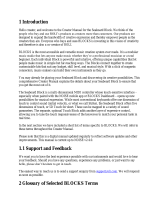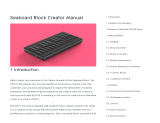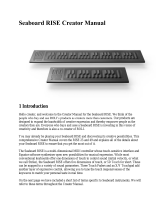
with the X’s representing the last 4 digits of the serial number which is located on the
underside of the Block.
Connect any additional Blocks that you have purchased to the DNA ports of the Lightpad
Block to register them now.
Once your Blocks are connected, select “Register Block.”
Your Blocks will now be registered to your account on NOISE.fm.
If you are prompted to update the firmware, you should do so now.
You are now connected and ready to make music.
If you are using Blocks with third-party applications rather than with NOISE, you may also
register your Blocks on My ROLI. Once you’ve created a MyROLI account, click “Register a
Product.” Enter the serial number found on the bottom of your Block for both the “Product
Registration Code” and “Serial Number” fields, and then click “Register.”
Updating Firmware
You may be prompted to update the firmware during this setup. This is highly recommended. It’s
important that you update to the latest firmware as periodic updates improve functionality and
introduce new features.
To update the firmware for your Lightpad Block, launch NOISE and connect your Block. In
NOISE, click the Settings icon in the upper-right corner, and then click “Firmware.” NOISE will
look for BLOCKS updates. If there are new firmware updates, you may select “Click to Update.”
The update will take a few minutes to process. When the update is finished, your Block will
restart. After your Block restarts, reconnect it to NOISE by clicking “OK” and then clicking on
the name of your Block.
Lightpad Blocks need at least 30% battery remaining in order to update the firmware. If you are
not able to update your Block’s firmware, make sure it is charged and try again.
Re-Connecting to NOISE
To re-connect your Blocks to NOISE after the initial setup please follow the steps below:
Turn Bluetooth ‘ON’ on your iOS device.
Turn on the Lightpad Block by pressing the power button.
The Lightpad Block will power up in Bluetooth pairing mode as long as it is not
connected by cable to a computer. This is indicated by a blue light on the power button
and an expanding blue ring displayed on the Lightpad Surface. If there is no blue light
then please press the power button once to enter pairing mode.
Launch NOISE on your iOS device.
Press the Bluetooth icon in NOISE and select ‘Lightpad Block XXX’ from the list of
Bluetooth MIDI Devices to pair app and hardware.
4 Learn























